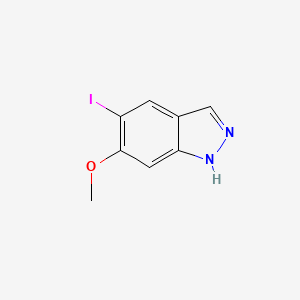![molecular formula C19H20FNO3 B3026791 (3R,4S)-3-[(2H-1,3-BENZODIOXOL-5-YLOXY)METHYL]-4-(4-FLUOROPHENYL)PIPERIDINE CAS No. 112058-85-2](/img/structure/B3026791.png)
(3R,4S)-3-[(2H-1,3-BENZODIOXOL-5-YLOXY)METHYL]-4-(4-FLUOROPHENYL)PIPERIDINE
Descripción general
Descripción
Métodos De Preparación
Rutas sintéticas y condiciones de reacción
La síntesis de paroxetina hemihidrato implica múltiples pasos, comenzando con la estructura química básica de la paroxetina. El proceso incluye la formación de la sal de clorhidrato y la posterior cristalización para obtener la forma hemihidratada. Las condiciones de reacción específicas, como la temperatura, el pH y la elección del solvente, son cruciales para garantizar la pureza y el rendimiento del producto final .
Métodos de producción industrial
La producción industrial de paroxetina hemihidrato sigue rutas sintéticas similares, pero a mayor escala. El proceso está optimizado para la eficiencia y la rentabilidad, a menudo involucrando sistemas automatizados y estrictas medidas de control de calidad para mantener la consistencia y la pureza .
Análisis De Reacciones Químicas
Tipos de reacciones
La paroxetina hemihidrato se somete a diversas reacciones químicas, que incluyen:
Oxidación: Implica la adición de oxígeno o la eliminación de hidrógeno.
Reducción: Implica la adición de hidrógeno o la eliminación de oxígeno.
Sustitución: Implica el reemplazo de un átomo o grupo de átomos por otro
Reactivos y condiciones comunes
Los reactivos comunes utilizados en estas reacciones incluyen agentes oxidantes como el permanganato de potasio, agentes reductores como el hidruro de litio y aluminio, y varios nucleófilos para reacciones de sustitución. Las condiciones de reacción como la temperatura, el solvente y los catalizadores juegan un papel significativo en la determinación de la vía de reacción y el rendimiento .
Productos principales
Los productos principales formados a partir de estas reacciones dependen de los reactivos y condiciones específicos utilizados. Por ejemplo, la oxidación puede producir derivados hidroxilados, mientras que la reducción puede producir compuestos desoxigenados .
Aplicaciones Científicas De Investigación
La paroxetina hemihidrato tiene una amplia gama de aplicaciones de investigación científica:
Química: Se utiliza como compuesto de referencia en estudios analíticos y desarrollo de métodos.
Biología: Se estudia por sus efectos en los sistemas de neurotransmisores y las vías de señalización celular.
Industria: Se utiliza en el desarrollo de nuevas formulaciones farmacéuticas y sistemas de administración de fármacos
Mecanismo De Acción
La paroxetina hemihidrato ejerce sus efectos inhibiendo la recaptación de serotonina, un neurotransmisor, en la neurona presináptica. Esta inhibición aumenta la concentración de serotonina en la hendidura sináptica, mejorando la neurotransmisión serotoninérgica. El compuesto también inhibe la actividad de la cinasa 2 del receptor acoplado a proteína G (GRK2), lo que contribuye a sus efectos terapéuticos .
Comparación Con Compuestos Similares
La paroxetina hemihidrato se compara con otros inhibidores selectivos de la recaptación de serotonina como:
- Fluoxetina
- Sertralina
- Citalopram
- Escitalopram
Si bien todos estos compuestos comparten un mecanismo de acción similar, la paroxetina hemihidrato es única en sus efectos inhibitorios específicos sobre GRK2, lo que puede contribuir a su perfil terapéutico distintivo .
Propiedades
IUPAC Name |
(3R,4S)-3-(1,3-benzodioxol-5-yloxymethyl)-4-(4-fluorophenyl)piperidine | |
|---|---|---|
| Details | Computed by Lexichem TK 2.7.0 (PubChem release 2021.05.07) | |
| Source | PubChem | |
| URL | https://pubchem.ncbi.nlm.nih.gov | |
| Description | Data deposited in or computed by PubChem | |
InChI |
InChI=1S/C19H20FNO3/c20-15-3-1-13(2-4-15)17-7-8-21-10-14(17)11-22-16-5-6-18-19(9-16)24-12-23-18/h1-6,9,14,17,21H,7-8,10-12H2/t14-,17-/m1/s1 | |
| Details | Computed by InChI 1.0.6 (PubChem release 2021.05.07) | |
| Source | PubChem | |
| URL | https://pubchem.ncbi.nlm.nih.gov | |
| Description | Data deposited in or computed by PubChem | |
InChI Key |
AHOUBRCZNHFOSL-RHSMWYFYSA-N | |
| Details | Computed by InChI 1.0.6 (PubChem release 2021.05.07) | |
| Source | PubChem | |
| URL | https://pubchem.ncbi.nlm.nih.gov | |
| Description | Data deposited in or computed by PubChem | |
Canonical SMILES |
C1CNCC(C1C2=CC=C(C=C2)F)COC3=CC4=C(C=C3)OCO4 | |
| Details | Computed by OEChem 2.3.0 (PubChem release 2021.05.07) | |
| Source | PubChem | |
| URL | https://pubchem.ncbi.nlm.nih.gov | |
| Description | Data deposited in or computed by PubChem | |
Isomeric SMILES |
C1CNC[C@@H]([C@H]1C2=CC=C(C=C2)F)COC3=CC4=C(C=C3)OCO4 | |
| Details | Computed by OEChem 2.3.0 (PubChem release 2021.05.07) | |
| Source | PubChem | |
| URL | https://pubchem.ncbi.nlm.nih.gov | |
| Description | Data deposited in or computed by PubChem | |
Molecular Formula |
C19H20FNO3 | |
| Details | Computed by PubChem 2.1 (PubChem release 2021.05.07) | |
| Source | PubChem | |
| URL | https://pubchem.ncbi.nlm.nih.gov | |
| Description | Data deposited in or computed by PubChem | |
DSSTOX Substance ID |
DTXSID90860771 | |
| Record name | (+)-Paroxetine | |
| Source | EPA DSSTox | |
| URL | https://comptox.epa.gov/dashboard/DTXSID90860771 | |
| Description | DSSTox provides a high quality public chemistry resource for supporting improved predictive toxicology. | |
Molecular Weight |
329.4 g/mol | |
| Details | Computed by PubChem 2.1 (PubChem release 2021.05.07) | |
| Source | PubChem | |
| URL | https://pubchem.ncbi.nlm.nih.gov | |
| Description | Data deposited in or computed by PubChem | |
CAS No. |
112058-85-2 | |
| Record name | Paroxetine, (+)- | |
| Source | ChemIDplus | |
| URL | https://pubchem.ncbi.nlm.nih.gov/substance/?source=chemidplus&sourceid=0112058852 | |
| Description | ChemIDplus is a free, web search system that provides access to the structure and nomenclature authority files used for the identification of chemical substances cited in National Library of Medicine (NLM) databases, including the TOXNET system. | |
| Record name | (+)-Paroxetine | |
| Source | EPA DSSTox | |
| URL | https://comptox.epa.gov/dashboard/DTXSID90860771 | |
| Description | DSSTox provides a high quality public chemistry resource for supporting improved predictive toxicology. | |
| Record name | PAROXETINE, (+)- | |
| Source | FDA Global Substance Registration System (GSRS) | |
| URL | https://gsrs.ncats.nih.gov/ginas/app/beta/substances/58SBH37T77 | |
| Description | The FDA Global Substance Registration System (GSRS) enables the efficient and accurate exchange of information on what substances are in regulated products. Instead of relying on names, which vary across regulatory domains, countries, and regions, the GSRS knowledge base makes it possible for substances to be defined by standardized, scientific descriptions. | |
| Explanation | Unless otherwise noted, the contents of the FDA website (www.fda.gov), both text and graphics, are not copyrighted. They are in the public domain and may be republished, reprinted and otherwise used freely by anyone without the need to obtain permission from FDA. Credit to the U.S. Food and Drug Administration as the source is appreciated but not required. | |
Synthesis routes and methods I
Procedure details










Synthesis routes and methods II
Procedure details








Synthesis routes and methods III
Procedure details





Retrosynthesis Analysis
AI-Powered Synthesis Planning: Our tool employs the Template_relevance Pistachio, Template_relevance Bkms_metabolic, Template_relevance Pistachio_ringbreaker, Template_relevance Reaxys, Template_relevance Reaxys_biocatalysis model, leveraging a vast database of chemical reactions to predict feasible synthetic routes.
One-Step Synthesis Focus: Specifically designed for one-step synthesis, it provides concise and direct routes for your target compounds, streamlining the synthesis process.
Accurate Predictions: Utilizing the extensive PISTACHIO, BKMS_METABOLIC, PISTACHIO_RINGBREAKER, REAXYS, REAXYS_BIOCATALYSIS database, our tool offers high-accuracy predictions, reflecting the latest in chemical research and data.
Strategy Settings
| Precursor scoring | Relevance Heuristic |
|---|---|
| Min. plausibility | 0.01 |
| Model | Template_relevance |
| Template Set | Pistachio/Bkms_metabolic/Pistachio_ringbreaker/Reaxys/Reaxys_biocatalysis |
| Top-N result to add to graph | 6 |
Feasible Synthetic Routes
Descargo de responsabilidad e información sobre productos de investigación in vitro
Tenga en cuenta que todos los artículos e información de productos presentados en BenchChem están destinados únicamente con fines informativos. Los productos disponibles para la compra en BenchChem están diseñados específicamente para estudios in vitro, que se realizan fuera de organismos vivos. Los estudios in vitro, derivados del término latino "in vidrio", involucran experimentos realizados en entornos de laboratorio controlados utilizando células o tejidos. Es importante tener en cuenta que estos productos no se clasifican como medicamentos y no han recibido la aprobación de la FDA para la prevención, tratamiento o cura de ninguna condición médica, dolencia o enfermedad. Debemos enfatizar que cualquier forma de introducción corporal de estos productos en humanos o animales está estrictamente prohibida por ley. Es esencial adherirse a estas pautas para garantizar el cumplimiento de los estándares legales y éticos en la investigación y experimentación.

![2-Thiophenecarboxamide, 5-chloro-N-[(3R,5S)-5-(4-morpholinylcarbonyl)-1-[(1,2,3,4-tetrahydro-2-methyl-6-isoquinolinyl)carbonyl]-3-pyrrolidinyl]-](/img/structure/B3026709.png)
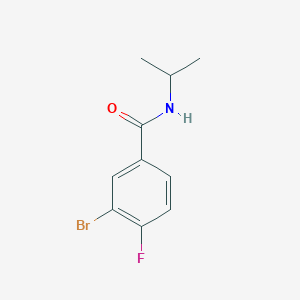



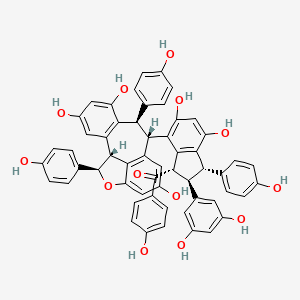
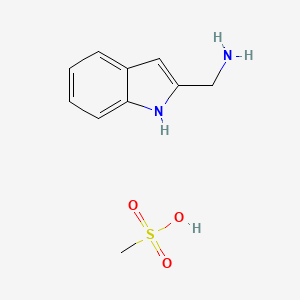

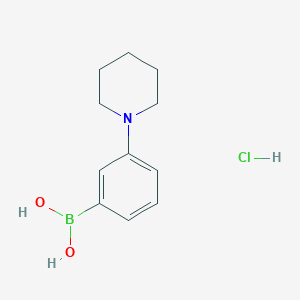
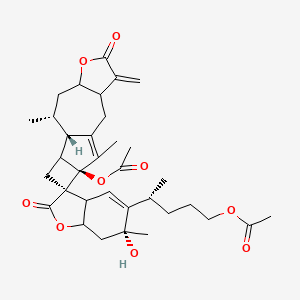


![6-bromo-7-methyl-1H-pyrrolo[3,2-c]pyridine](/img/structure/B3026730.png)
